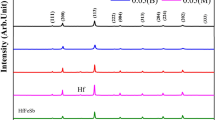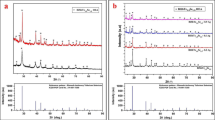Abstract
In this study, the effects of three different types of doping elements on the thermoelectric properties, mechanical properties and thermal stability of Zr0.95A0.05NiSn (A = p-type dopant: Sc; isoelectronic dopants: Zr, Ti and Hf; n-type dopants: V, Nb and Ta) were systematically investigated. The sample was prepared by smelting multiple magnetic suspensions in combination with the spark plasma sintering method. X-ray diffraction analysis and scanning electron microscopy observations showed that nearly single-phase half-Heusler compounds were obtained for the levitation-melted ingots. The results demonstrate that p-type doping causes the semiconductor behavior of this material to change from n type to p type, resulting in poor thermoelectric properties. The mass fluctuations and stress fluctuations introduced by the isoelectronic doping cause the thermal conductivity to decrease, and n-type dopants increase the carrier concentration of the material, resulting in an increase in its power factor. On this basis, the ZTmax value of the Zr0.95M0.05NiSn (M = Ti0.25Hf0.25Nb0.25V0.25) sample reached 0.76, which is 58% higher than that of ZrNiSn within the measurement temperature range. In addition, all of the samples maintained excellent mechanical properties, and their microhardness (HV) was greater than 900; no significant endothermic or exothermic phenomenon of all these samples was observed from room temperature to 700 °C, confirming their good thermal stability.






Similar content being viewed by others
References
Huang LH, Zhang QY, Yuan B, Lai X, Yan X, Ren ZF (2016) Recent progress in half-Heusler thermoelectric materials. Mater Res Bull 76:107–112
Bos JWG, Downie RA (2014) Half-Heusler thermoelectrics: a complex class of materials. J Phys Condens Matter 26:433201
Zhu TJ, Fu CG, Xie HH, Liu YT, Zhao XB (2015) High efficiency half-Heusler thermoelectric materials for energy harvesting. Adv Energy Mater 5:1500588
Bulman G, Cook B (2014) High-efficiency energy harvesting using TAGS-85/half-Heusler thermoelectric devices. In: Dhar NK, Balaya P, Dutta AK (eds) Energy harvesting and storage: materials, devices, and applications, vol 9115, p. 911507
Xie HH, Wang H, Fu CG et al (2014) The intrinsic disorder related alloy scattering in ZrNiSn half-Heusler thermoelectric materials. Sci Rep 4:6888
Kutorasinski K, Tobola J, Kaprzyk S (2014) Application of Boltzmann transport theory to disordered thermoelectric materials: Ti(Fe Co, Ni)Sb half-Heusler alloys. Phys Status Solidi A Appl Mater Sci 211:1229–1234
Chaput L, Tobola J, Pecheur P, Scherrer H (2006) Electronic structure and thermopower of Ni(Ti0.5Hf0.5)Sn and related half-Heusler phases. Phys Rev B 73:045121
Tan G, Zhao L-D, Kanatzidis MG (2016) Rationally designing high-performance bulk thermoelectric materials. Chem Rev 116:12123–12149
Zhu TJ, Liu YT, Fu CG, Heremans JP, Snyder JG, Zhao XB (2017) Compromise and synergy in high-efficiency thermoelectric materials. Adv Mater 29:1605884
Fitriani ROvik, Long BD et al (2016) A review on nanostructures of high-temperature thermoelectric materials for waste heat recovery. Renew Sustain Energy Rev 64:635–659
Dehkordi AM, Zebarjadi M, He J, Tritt TM (2015) Thermoelectric power factor: enhancement mechanisms and strategies for higher performance thermoelectric materials. Mater Sci Eng R-Rep 97:1–22
Xie HH, Wang H, Pei YZ et al (2013) Beneficial contribution of alloy disorder to electron and phonon transport in half-Heusler thermoelectric materials. Adv Func Mater 23:5123–5130
Chen L, Liu YM, He J, Tritt TM, Poon SJ (2017) High thermoelectric figure of merit by resonant dopant in half-Heusler alloys. AIP Adv 7:065208
Liu YT, Xie HH, Fu CG, Snyder GJ, Zhao XB, Zhu TJ (2015) Demonstration of a phonon-glass electron-crystal strategy in (Hf, Zr)NiSn half-Heusler thermoelectric materials by alloying. J Mater Chem A 3:22716–22722
Zhang H, Wang YM, Dahal K et al (2016) Thermoelectric properties of n-type half-Heusler compounds (Hf0.25Zr0.75)(1−x)NbxNiSn. Acta Mater 113:41–47
Zhao DG, Zuo M, Wang ZQ, Teng XY, Geng HR (2014) Synthesis and thermoelectric properties of tantalum-doped ZrNiSn half-Heusler alloys. Funct Mater Lett 7:1450032
Downie RA, Popuri SR, Ning HP, Reece MJ, Bos JWG (2014) Effect of spark plasma sintering on the structure and properties of Ti1–xZrxNiSn half-Heusler alloys. Materials 7:7093–7104
Krez J, Schmitt J, Snyder GJ, Felser C, Hermes W, Schwind M (2014) Optimization of the carrier concentration in phase-separated half-Heusler compounds. J Mater Chem A 2:13513–13518
Chauhan NS, Bathula S, Vishwakarma A, Bhardwaj R, Gahtori B, Kumar A, Dhar A (2018) Vanadium-doping-induced resonant energy levels for the enhancement of thermoelectric performance in Hf-free ZrNiSn half-Heusler alloys. ACS Appl Energy Mater 1(2):757–764
Yan J, Liu FS et al (2018) Suppression of the lattice thermal conductivity in NbFeSb-based half-Heusler thermoelectric materials through high entropy effects. Scr Mater 157:129–134
Chauhan NS, Bathula S, Vishwakarma A et al (2018) Compositional tuning of ZrNiSn half-Heusler alloys: thermoelectric characteristics and performance analysis. J Phys Chem Solids 123:105–122
Schmitt J, Gibbs ZM, Snyder GJ, Felser C (2015) Resolving the true band gap of ZrNiSn half-Heusler thermoelectric materials. Mater Horiz 2:68–75
Hattori K, Miyazaki H, Yoshida K, Inukai M, Nishino Y (2015) Direct observation of the electronic structure in thermoelectric half-Heusler alloys Zr1−xMxNiSn (M = Y and Nb). J Appl Phys 117:205102
Rogl G, Sauerschnig P, Rykavets Z et al (2017) (V, Nb)-doped half Heusler alloys based on {Ti, Zr, Hf}NiSn with high ZT. Acta Mater 131:336–348
Muta H, Kanemitsu T, Kurosaki K, Yamanaka S (2006) Substitution effect on thermoelectric properties of ZrNiSn based half-Heusler compounds. Mater Trans 47:1453–1457
Fu CG, Xie HH, Zhu TJ, Xie J, Zhao XB (2012) Enhanced phonon scattering by mass and strain field fluctuations in Nb substituted FeVSb half-Heusler thermoelectric materials. J Appl Phys 112:124915
Rogl G, Grytsiv A, Gurth M et al (2016) Mechanical properties of half-Heusler alloys. Acta Mater 107:178–195
Verges MA, Schilling PJ, Germond JD et al (2012) Young’s modulus and hardness of Zr0.5Hf0.5CoxRh1−xSb0.99Sn0.01 and Zr0.5Hf0.5CoxIr1-xSb0.99Sn0.01 half-Heusler alloys. Proc ASME Int Mech Eng Congr Expo 5:1427–1433
Zhao LD, Zhang BP, Li JF, Zhou M, Liu WS (2007) Preparation and properties of Nano-SiC dispersed Bi2Te3 thermoelectric materials. Rare Met Mater Eng 36:408–411
Acknowledgements
This work was supported by the National Natural Science Foundation of China (Nos. 51701126 and 51571144) and the Shenzhen Science and Technology Research Grant (No. JCYJ20150827155136104).
Author information
Authors and Affiliations
Corresponding author
Ethics declarations
Conflicts of interest
There are no conflicts of interest in this work.
Additional information
Publisher's Note
Springer Nature remains neutral with regard to jurisdictional claims in published maps and institutional affiliations.
Electronic supplementary material
Below is the link to the electronic supplementary material.
Rights and permissions
About this article
Cite this article
Gong, B., Liu, F., Zhu, J. et al. Effects of Sc, Ti, Hf, V, Nb and Ta doping on the properties of ZrNiSn alloys. J Mater Sci 54, 10325–10334 (2019). https://doi.org/10.1007/s10853-019-03623-4
Received:
Accepted:
Published:
Issue Date:
DOI: https://doi.org/10.1007/s10853-019-03623-4




